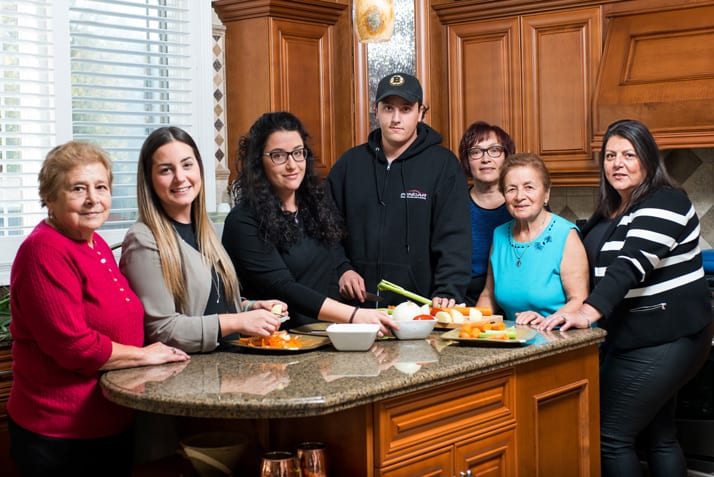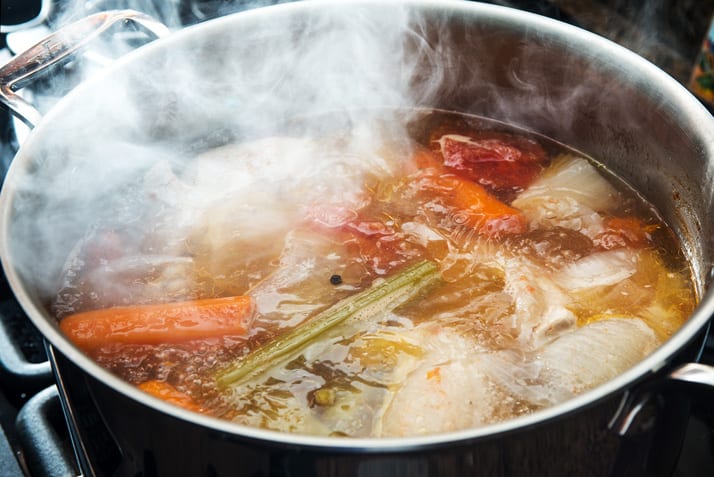
I love when my family comes home and enthusiastically asks “are you making nonna’s soup”? Their clue is the wonderful and comforting aroma that permeates the entire house while the brodo gently simmers. There is nothing that warms your belly and soul more than nonna’s recipe for brodo, homemade chicken broth. Did you know that brodo is the “cure” for almost anything that ails you according to nonna:)
Chicken broth is a staple in most Italian households. You can rest assured that there will be a few litres in the freezer at all times. It is used in so many dishes and hence is made often whether it is winter or summer. You need a really good homemade brodo to make pastina, stracciatella, vegetable soups, risottos, sauces, and chicken dishes pop with flavour. In our house, there is always a negotiation that occurs when it comes time to choose the soup noodle. Will it be acini di pepe, farfalline, shells, or ditalini? Which is your favourite pasta noodle for soup?
Go to recipe
For this post, my cousin Teresa and I got our moms (sisters Caterina and Maria) together for a day of brodo preparation and to reminisce about their childhood. They told us how they learned to make brodo with their mom, “discussed” who made a better soup (teehee), and gave us little tips and tricks they have learned along the way. Of course, each of them remembers the details just a little differently which made for an entertaining afternoon! Even the grandkids took part but of course the nonnas were in charge!


The ingredients for this recipe are basic but make such a flavourful broth! Our moms use “soup” chickens cut into large pieces, with the excess fat removed. Remember, when they make a pot of broth they usually double or even triple this recipe! Typically, the chickens you find in regular grocery stores are classified by weight and age. Soup chickens are older chickens (usually hens) that are over 10 months old. They range in weight between 4-7 pounds and because they are older, their meat is tougher and requires a long and slow cooking process. However, they are considered more flavourful than a younger broiler or fryer chicken and that is why many people prefer them for making broth. You can of course use any chicken though!

Nonna Caterina and Nonna Maria were taught to wash the chicken well, remove any excess fat then place in a pot of cold water, allow it to come to a boil then immediately remove the chicken and discard this water. They then rinse off the pre-boiled chicken and add it to a new pot of cold water along with the other ingredients. This step is done in order to minimize the foam from forming on top (you can skim off any that does still happen to appear). If you want to skip the pre-boil step, just skim off the foam as it forms.
Whether you do the pre-boil step or not, it is really important to start with cold water, allow everything to come to a boil then reduce the heat so that the broth cooks at a gentle simmer.
Secret reveal here – the cooked chicken meat that completely falls apart when the soup is finished cooking is the best ever. We all fight over it and if nonna is lucky there might be some left to chop up and add to the soup! Oh and the veggies that have been in there for the entire cooking time are delicious so don’t throw all this goodness out after you have strained the soup!


While the broth was cooking, we were asking Nonna Caterina and Nonna Maria about making this back in Italy when they were younger. They recalled the distinct flavour it had using their own homegrown chickens. Having said that, today we do have the luxury of readily finding fresh chickens, even organic and free range chickens.
Both nonnas said they often add some beef shank to the soup for extra flavour but this is optional.
Once the broth has finished cooking you want to remove all of the vegetables and chicken and set aside as the cook’s treat! Strain the rest of the broth through a fine sieve or a colander lined with cheese cloth. Allow the finished and strained broth to cool in a safe manner. It is important to know how to cool foods properly in order to avoid any food borne illness. The following link is a helpful resource for instructions on the proper cooling of soup: www.extension.umn.edu/food/food-safety/preserving/safe-meals/cool-soup-safely/.
If necessary, once chilled, you can easily scrape off any fat that congeals on top.
For longer storage, divide the refrigerated stock into food safe containers and place in the freezer for later use.
Brodo- Homemade Chicken Broth
Ingredients
- Soup chicken pieces (3-3.5 pounds total)
- 4.5–5 litres cold water to make the broth (you will need extra if doing the chicken pre-boil step)
- 2 roma tomates (cut in half)
- 2 large carrots (cut in half)
- 2 celery stalks (cut in half)
- 1 medium onion (cut in half)
- 1 medium new potato (peeled but left whole)
- 1/2 tsp (2.5ml) whole black peppercorns
- salt to taste
Instructions
- Rinse the chicken well with cold water and trim off any excess fat.
- Place in a stock pot and add enough water to completely cover the chicken. Place on the stove and heat until the water begins to boil then immediately remove the pot from the stove. Lift out the chicken and discard the water. Rinse off the chicken.
- Into a clean stock pot, place the pre-boiled and rinsed chicken pieces along with all of the other ingredients except the salt.
- Cover with 4.5-5 litres of cold water. Place over medium-high heat and allow everything to come to a boil. As soon as it begins to boil, reduce the heat enough to allow the soup to simmer gently. Partially cover the pot and allow to simmer for 2.5-3 hours. Test for seasoning and add salt to your liking.
- The chicken should be very tender and easily falls off the bone.
- Remove the chicken and vegetables from the pot then strain the broth through a fine sieve or cheesecloth-lined colander.
- Follow proper cooling methods for safe food handling (see resource link in post).
Notes
- It is easy to skim off any fat that congeals on the surface once it has cooled in the refrigerator.




Sorry, the comment form is closed at this time.